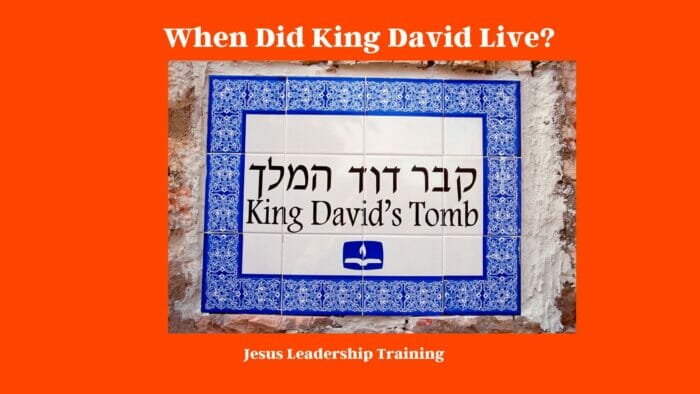Unravel the enigmatic life of King David, a formidable figure of Biblical history. Explore the timeline of King David’s reign, delving into historical records and biblical accounts, questioning “When did King David live?” and many other fascinating aspects of his life.
When Did King David Live? – An aura of mystery envelops many figures in biblical history. Amongid king david live them, King David is a character who has always intrigued historians, theologians, and laymen alike. But one question that remains at the forefront is: When did King David live? The chronology of this legendary king, the formidable warrior, the poet, and the harp-playing shepherd, is intriguing and offers rich insights into a vibrant period of history. So, grab a cup of coffee, and let’s embark on this remarkable journey through time.
Table of Contents
When Did King David Live?
The life of King David, as depicted in the Hebrew Bible, the Christian Old Testament, and the Islamic Quran, is a captivating narrative that has resonated across centuries. Historically, the consensus among scholars places King David’s existence and reign during the Iron Age, specifically around the 10th century BCE. His life, marked by triumphs and trials, is an engaging mix of heroic feats, divine providence, personal failings, and enduring faith.
Major Events in King Davids Life From the Old Testament
Here is a table timeline of major events in the life of King David, as described in the Old Testament:
| Time Period | Events |
|---|---|
| Around 1040 BCE | – David is anointed as the future king of Israel by the prophet Samuel. |
| Around 1025 BCE | – David defeats the Philistine giant Goliath. |
| Around 1010 BCE | – David becomes king of Israel after the death of King Saul. – Jerusalem is established as the capital. – The Ark of the Covenant is brought to Jerusalem. |
| Around 1003 BCE | – David leads successful military campaigns, expanding Israel’s territory. |
| Around 993 BCE | – David has an affair with Bathsheba, resulting in the death of Uriah the Hittite and the birth of Solomon. |
| Around 992 BCE | – David’s son Absalom rebels against him, leading to conflict and David’s temporary exile. |
| Around 970 BCE | – David dies, and his son Solomon succeeds him as king. |
This table provides a chronological overview of the major events in King David’s life as documented in the Old Testament. It highlights significant milestones, such as his anointment, victory over Goliath, ascension to the throne, military conquests, personal struggles, and ultimately his death and succession.

These events shaped David’s legacy as a renowned king of Israel, known for his military prowess, his devotion to Jerusalem, and his role in establishing the Davidic dynasty, which held significant importance in biblical history.
The Times of King David: A Historical Perspective
In the annals of history, King David’s period is known as Iron Age IIA, roughly 1000-925 BCE. This time was marked by substantial socio-political shifts in the ancient Near East. These shifts were significant in shaping the geopolitical contours of the region, with the establishment of territorial kingdoms like Israel and Judah.
Historical Records and Biblical Accounts
In understanding when King David lived, we rely on a mix of archaeological evidence, historical records, and biblical accounts. The Tel Dan Stele and the Mesha Stele are among the key historical records that provide evidence of King David’s existence. The Tel Dan Stele, discovered in 1993, references the “House of David,” providing the first archaeological affirmation of King David outside the Bible.
Tel Dan Stele – Israel Museum
The Tel Dan Stele is an ancient stone inscription discovered in 1993 during excavations at Tel Dan in northern Israel. It is an important archaeological artifact that provides valuable insights into the history and culture of the ancient Near East, particularly the Kingdom of Israel.
The stele itself is a fragmentary inscription carved on a black basalt stone. It consists of several lines of text written in ancient Aramaic, a language widely used in the region during that time. The inscription dates back to the 9th century BCE, specifically to the period of the Israelite monarchy.
One of the most significant aspects of the Tel Dan Stele is that it contains an inscription referring to the “House of David,” which is considered to be the first extra-biblical reference to King David, the renowned biblical figure. This inscription provides strong evidence for the existence of a historical figure named David who ruled over a kingdom in ancient Israel.

The Tel Dan Stele also mentions a victorious Aramean king from Damascus named Hazael, who is known from other ancient texts and is associated with conflicts between Aram and Israel during that period.
The discovery of the Tel Dan Stele and its mention of the “House of David” has sparked scholarly discussions and debates regarding the historicity of the biblical accounts and the reliability of the biblical narratives concerning King David. It has added an important layer of historical evidence and context to the understanding of ancient Israelite society and its rulers.
The stele is currently housed in the Israel Museum in Jerusalem, where it can be studied and appreciated by scholars and visitors alike.
The Early Life of David
Biblical accounts present a vivid picture of David’s early life. Born in Bethlehem to Jesse of the tribe of Judah, David emerged from humble beginnings to ascend to the throne. He spent his early years as a shepherd, a profession that endowed him with the necessary skills and courage to confront predators, and later, enemies of his people.

Family Members of King David, as Described in the Old Testament
Here is a table listing the family members of King David, as described in the Old Testament:
| Family Member | Relationship to King David |
|---|---|
| Jesse | Father |
| David | King of Israel, son of Jesse |
| Samuel | Prophet and anointed David as king |
| Abigail | Wife of David, former wife of Nabal |
| Michal | Daughter of King Saul, first wife of David |
| Bathsheba | Wife of Uriah the Hittite, later married to David |
| Solomon | Son of David and Bathsheba, successor to the throne |
| Amnon | Son of David and Ahinoam, half-brother of Absalom and Tamar |
| Absalom | Son of David and Maacah, rebelled against his father |
| Tamar | Daughter of David and Maacah, sister of Absalom |
| Adonijah | Son of David and Haggith, attempted to seize the throne |
| Nathan | Prophet, advisor to David and Solomon |
| Zeruiah | Sister of David, mother of Joab, Abishai, and Asahel |
| Joab | Nephew of David, commander of David’s army |
| Abishai | Nephew of David, commander of David’s army |
| Asahel | Nephew of David, commander of David’s army |
This table provides an overview of the family members associated with King David, the renowned biblical figure. It includes his immediate families, such as his father Jesse, his wives Abigail, Michal, and Bathsheba, as well as his sons Solomon, Amnon, Absalom, and Adonijah. It also includes significant individuals like Samuel, the prophet who anointed David as king, and Nathan, a prophet and advisor to David and Solomon. Additionally, it includes notable figures from David’s extended family, including his sister Zeruiah and her sons Joab, Abishai, and Asahel, who played important roles in David’s life and reign.
Citation: Family relationships and individuals are mentioned in the Old Testament, specifically in the books of 1 Samuel, 2 Samuel, and 1 Kings.
David’s Anointment and Battle with Goliath
David’s journey to kingship began with his anointment by the Prophet Samuel, as instructed by God. He rose to prominence following his famous victory over the Philistine giant Goliath, demonstrating exceptional courage and faith in God.
Events Depicting the Battle Between David and Goliath
Here is a table of events depicting the battle between David and Goliath, as described in the Old Testament:
| Event | Description |
|---|---|
| Goliath’s Challenge | The Philistine giant Goliath, standing over nine feet tall, challenges the Israelites to send out a champion for single combat to decide the outcome of the battle. |
| David’s Arrival | David, a young shepherd boy, arrives at the Israelite camp to deliver supplies and hears Goliath’s challenge. |
| David’s Confidence | David expresses his confidence in God’s protection and volunteers to fight Goliath, despite the doubts and concerns of King Saul and the Israelite army. |
| Saul’s Armor Rejected | David rejects Saul’s armor and chooses instead to go into battle with his sling and five smooth stones from the brook. |
| Encounter with Goliath | David confronts Goliath on the battlefield, proclaiming his trust in God’s deliverance and the justice of the Israelite cause. |
| Sling and Stone | David uses his sling to launch a stone at Goliath, striking him in the forehead and causing him to fall. |
| Goliath’s Defeat | Goliath is killed by David, who then takes the giant’s own sword and beheads him, demonstrating the decisive victory of the Israelites. |
| Philistine Retreat | Witnessing the defeat of their champion, the Philistines flee, and the Israelites pursue them in a rout. |
| Israelite Triumph | The Israelites celebrate their victory over the Philistines and attribute it to God’s intervention through David. |
This table outlines the key events that occurred during the legendary battle between David and Goliath. It highlights David’s courageous decision to confront Goliath, his rejection of conventional armor in favor of his trust in God, and the miraculous outcome of the battle. The defeat of Goliath signifies a significant turning point in the conflict between the Israelites and the Philistines, demonstrating the triumph of faith, skill, and divine assistance over overwhelming odds..
David’s Relationship with King Saul
King Saul initially held David in high esteem, but the relationship soured as David’s popularity grew. Saul’s increasing paranoia and attempts on David’s life eventually led to a prolonged period of conflict.
David’s Reign as King
David’s reign as King of Israel marks a significant period in biblical history. According to the Bible, he ruled for 40 years, first in Hebron (for seven years) and then in Jerusalem (for the remaining 33 years). His reign was a period of military victories, territorial expansion, and relative peace.
King David and the City of Jerusalem
Jerusalem holds a special place in King David’s narrative. He conquered the city from the Jebusites, established it as his capital, and brought the Ark of the Covenant there, making it the religious center of his kingdom.
Major Events During King David’s Rule
Here is a table of major events during King David’s rule, as described in the Old Testament:
| Event | Description |
|---|---|
| Anointed as King | David is anointed as king of Israel, succeeding Saul and becoming the second king of the united kingdom of Israel and Judah. |
| Capture of Jerusalem | David captures the Jebusite stronghold of Jerusalem and establishes it as the capital city, known as the “City of David.” |
| Ark of the Covenant in Jerusalem | David brings the Ark of the Covenant to Jerusalem, signifying the presence of God among the people and solidifying Jerusalem’s status. |
| Military Campaigns and Expansion | David leads successful military campaigns, expanding the territory of Israel and subduing neighboring nations. |
| Bathsheba and Uriah’s Death | David’s affair with Bathsheba, the wife of Uriah the Hittite, leads to Uriah’s death and David’s marriage to Bathsheba. |
| Amnon and Tamar Tragedy | David’s son Amnon rapes his half-sister Tamar, leading to family turmoil and strained relationships. |
| Absalom’s Rebellion | David’s son Absalom rebels against him, attempting to seize the throne and forcing David into exile. |
| Return to Jerusalem | David regains control of Jerusalem after Absalom’s rebellion is quelled, marking his return as the rightful king. |
| Solomon’s Succession | David designates his son Solomon as his successor, ensuring the continuation of the Davidic dynasty. |
| David’s Death and Legacy | David dies, leaving a lasting legacy as one of Israel’s greatest kings and as the ancestor of Jesus Christ according to the Bible. |
This table provides an overview of significant events during King David’s rule as documented in the Old Testament. It highlights key moments such as his anointment as king, the capture of Jerusalem, military conquests, personal scandals and family tragedies, rebellions, and the establishment of the Davidic dynasty. David’s rule is characterized by military prowess, political consolidation, and religious significance, shaping the future of Israel and establishing a prominent lineage.
Citation: Events based on the biblical accounts found in the books of Samuel and Kings in the Old Testament.
King David’s Achievements and Failings
David’s reign was marked by significant achievements
, including unifying the tribes of Israel and establishing Jerusalem as the political and spiritual center. Yet, his life was not without controversy. His adulterous relationship with Bathsheba and the arranged death of her husband Uriah were profound failings that had serious personal and political consequences.
Legacy of King David
The impact of King David’s reign extended far beyond his lifetime. He is remembered not only as a successful king but also as a man after God’s own heart.
Here is a table listing the lineage of Jesus from King David, as presented in the New Testament:
| Generation | Ancestor |
|---|---|
| David | King David |
| Solomon | King Solomon |
| Rehoboam | King Rehoboam |
| Abijah | King Abijah |
| Asa | King Asa |
| Jehoshaphat | King Jehoshaphat |
| Jehoram | King Jehoram |
| Uzziah | King Uzziah |
| Jotham | King Jotham |
| Ahaz | King Ahaz |
| Hezekiah | King Hezekiah |
| Manasseh | King Manasseh |
| Amon | King Amon |
| Josiah | King Josiah |
| Jeconiah | King Jeconiah |
| Shealtiel | Shealtiel |
| Zerubbabel | Zerubbabel |
| Abiud | Abiud |
| Eliakim | Eliakim |
| Azor | Azor |
| Zadok | Zadok |
| Achim | Achim |
| Eliud | Eliud |
| Eleazar | Eleazar |
| Matthan | Matthan |
| Jacob | Jacob |
| Joseph | Joseph (husband of Mary) |
| Jesus | Jesus |
This table presents the lineage of Jesus, tracing his ancestry back to King David. According to the New Testament, Jesus is considered to be a descendant of King David through his earthly father Joseph, although his birth was through the miraculous intervention of the Holy Spirit.
This lineage highlights the fulfillment of the Messianic prophecy that the Messiah would come from the house of David. It signifies Jesus’ royal lineage and establishes his rightful claim as the promised Messiah.
Citation: Lineage based on the genealogical accounts found in the New Testament, specifically in the books of Matthew (Matthew 1:1-16) and Luke (Luke 3:23-38).
David’s Dynasty: The House of David
The “House of David” refers to the dynasty established by King David, with his descendants holding the right to rule. The most famous of David’s lineage is King Solomon, known for his wisdom and the construction of the First Temple in Jerusalem.
David in Literature and Art
King David’s life and deeds have been a rich source of inspiration for various forms of literature and art throughout the centuries. His story has been depicted in paintings, sculptures, music, and literature, attesting to his enduring influence.
FAQs
Q1: When did King David live?
King David is believed to have lived and reigned during the Iron Age, around the 10th century BCE.
Q2: How long did King David reign?
According to biblical accounts, King David reigned for 40 years — seven years in Hebron and 33 years in Jerusalem.
Q3: What is King David known for?
King David is known for his military victories, the unification of Israel, establishing Jerusalem as the capital, and his deep faith in God. He is also recognized for his failings, including his adultery with Bathsheba.
Q4: How did David become king?
David was anointed by the Prophet Samuel as the future king. After King Saul’s death, David was declared king by the tribe of Judah and later by the other tribes of Israel.
Q5: What is the House of David?
The House of David refers to the royal dynasty established by King David, with his descendants having the right to rule.
Q6: What is the significance of King David in Christianity?
King David is a significant figure in Christianity. He is revered as the greatest king of Israel and the ancestor of Jesus Christ, as mentioned in the Gospels of Matthew and Luke.
Final Thoughts – When Did King David Live
King David, a legendary figure from biblical history, was more than just a king. His life, which unfolded around the 10th century BCE, was an intricate tapestry of heroic deeds, divine guidance, personal transgressions, and an enduring legacy. Whether you approach him from a historical, religious, or cultural perspective, one cannot deny his significant impact. The question “When did King David live?” opens doors to an era that has shaped our religious and cultural landscape in profound ways.




